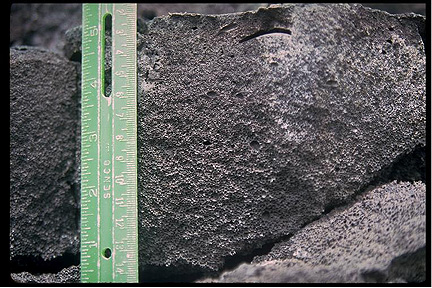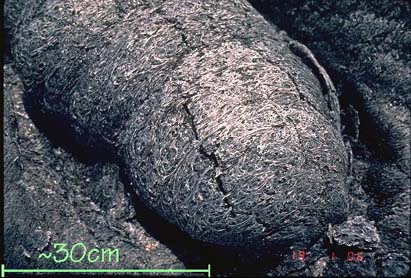During pahoehoe eruptions, lava continues to flow through earlier-formed toes, particularly those near the center of the flow field. This continued flow causes the walls separating individual toes to become soft and eventually the toes start to coalesce to form a lava tube.
Diagrammatic cross-sections through a pahoehoe flow (same location, different times; grey color is solidified, reds indicate still-fluid lava). Note how the toes on the edges become solidified while continued flow through those in the middle eventually softens and erodes the toe margins until a large master tube forms.
Lava tubes also form when small channels roof over (e.g. Greeley 1971; Peterson & Swanson 1974). Lava tubes are thus self-forming within a flow field, and like channels they develop downflow during an eruption. Lava tubes are very efficient transporters of lava from the vent to the flow front, and Laszlo Keszthelyi has recently calculated that lava flowing in a tube loses only about 1ºC of heat/kilometer. At the flow front, the lava behaves much like a river delta, forming small distributary tubes that continue to branch until they consist of the same type of single flow-unit tubes (toes) that have been forming the flow the whole way downslope.
Diagrammatic cross-sections through a pahoehoe flow (same time, different locations; grey is solid, reds are still fluid). A: Master tube formed within a pile of flow units, B: distributary tube system near flow front, continued flow in some of these will result in their merging to form a master tube, C: flow front consisting of numerous pahoehoe toes (adapted from Rowland & Walker 1990).
The amount of gas in lava at the flow front is somewhat lower than that at the vent because although lava tubes are good thermal insulators, they are not so well sealed that gas can be trapped. Gas escapes through cracks in the tube and also through skylights, places where the roof of a tube has fallen in to expose the flowing lava. Hot escaping fumes are strongly concentrated at skylights and they must be approached VERY carefully.
An active skylight formed on the main lava tube from the Kupa'ianaha vent, Kilauea east rift zone, November 1991. The skylight is about 2 m across.
Whenever the flow front of a flow stagnates on sub-horizontal surfaces (such as on the coastal plain), it starts to grow by inflation as well as by spreading. This growth by inflation has only recently been recognized as an important factor in flow field growth (Walker 1991; Hon & Kauahikaua 1991; Walker 1992). The initial advancing flow front is usually <1 m thick. Subsequent inflation of the flow can increase its thickness up to ~10 m.
Places where inflation is particularly concentrated are called tumuli (singular: tumulus). Tumuli range in size from a few square meters in area and ~1 m high to a few thousand square meters in area and ~10 m high. Tumuli are often ubiquitous on flat-lying portions of a pahoehoe flow field. There are also places that inflate less than the surrounding area. These are called lava-rise pits (Walker 1991).
A large tumulus developed in the 1859 Mauna Loa flow near the coast. Note George Walker (arrow) in the central cleft for scale
The lava of an advancing pahoehoe flow front is relatively vesicle-rich (although less gas-rich than near-vent "shelly" pahoehoe).
Photograph of shelly pahoehoe. Note that the surface skin is only a few cm thick. The lava has not drained away from under the skin but rather within a rapidly quenched outer skin, an initially foam-like mixture of lava and gas bubbles separated into a gas-only top and lava-only bottom. It is easy to see why walking on shelly pahoehoe is not a pleasant pastime.
This bubble-rich flow front pahoehoe has recently been termed s-type pahoehoe, the "s" standing for "spongy" which aptly describes its appearance in cross-section (Walker 1989). While the lava is still molten, vesicles often coalesce just beneath the quenched skin and this forms a mostly gas (and therefore weak) layer under the top 1-2mm of surface glass. This weak surface layer of s-type pahoehoe spalls off, sometimes only within a few days, exposing the texture of the underlying vesicles.

The vesicularity is also evident on the top surface of the lava, which consists of filamentous strands of vesicle walls that have been stretched as the skin deforms.

The lava that is stored within a flow field before being erupted, on the other hand, is distinctly vesicle-poor. It has been termed p-type pahoehoe (Wilmuth & Walker 1993) because the bottoms of these flow units commonly contain pipe vesicles. Flow units of p-type pahoehoe have an appearance that makes them appear to be less viscous and their thickness is often <10 cm. This low-lying appearance is mainly due to the small number of gas bubbles within the p-type pahoehoe; if you stir it with a rock hammer it definitely "feels" more viscous than the more common gas-rich s-type pahoehoe.
S-type and p-type pahoehoe together. Note the thinness of the p-type lava flow units compared to the more billowy and/or ropy forms of the s-type. The blue color is distinctive of fresh p-type pahoehoe.
Mauna Iki p-type pahoehoe erupted in 1920, showing the yellowish secondary mineral that usually develops on this type of lava. Note that the secondary mineral does not form near fractures, perhaps because it dissolves in rainwater that accumulates there.
When first erupted, p-type pahoehoe has a distinct shiny blue color. During weathering it develops a patchy ochre coating.
The top layer of this vesicle-poor lava strongly resembles obsidian and was originally thought to form when heavy rain falls while the lava is flowing (Wentworth & Macdonald 1953). Because you can see p-type pahoehoe flowing during any weather, this idea can easily be shown to be false. The most commonly held idea is that the paucity of vesicles is due to the prolonged storage within the flow field (up to a few days) prior to being forced onto the surface by an influx of new lava. During this storage gas bubbles are able to migrate upward and escape through fractures in the surface carapace. A competing idea (Hon & Kauahikaua 1991) is that p-type pahoehoe is actually richer in gas; the overburden of the solid flow surface has caused the gas to go back into solution.